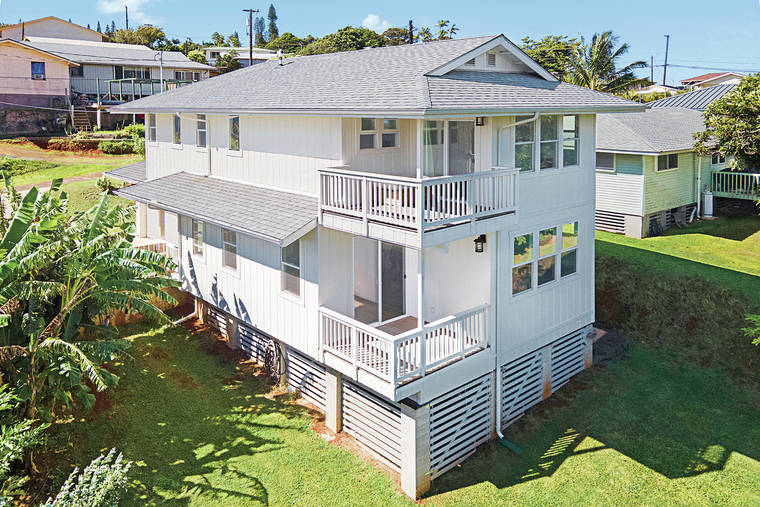LIHU’E — The Kaua‘i real estate market experienced a 26.04% drop in sales across every category from 2019 to 2020 at the end of the third quarter, according to information provided by Sirois Kaua‘i, a partner of Corcoran Pacific Properties.
Despite the overall plunge in sales, Sirois Kaua‘i realtor-partner Hannah Sirois projects those numbers to be streamlined with the 2019 numbers by the end of the fourth quarter of 2020.
The number of sales between January and March fell slightly in the first quarter, from 235 in 2019 to 227 in 2020.
In the second quarter, from April to June, was where the most significant fall on Kaua‘i occurred when sales dropped from 360 houses sold in 2019 compared to 172 in 2020 during a period when inter-island and trans-Pacific travel was banned and mandatory lockdowns were implemented.
Changing time, changing trends
Because of the COVID-19 pandemic, the industry had to make adjustments from the second quarter of 2020 to the third quarter by performing virtual showings, which allowed buyers to view and purchase properties remotely.
“What we now know is that homeowners and buyers across the country want their own stay at home haven,” Sirois said. “Whether it is a condo, cottage or a larger home.”
Addressing Kaua‘i’s housing shortage
For the last decade, the island of Kaua‘i has suffered a housing shortage, partly due to supply and demand, prices and infrastructure hindrances, like sewer systems and water.
The median price on single-family homes moved from $647,500 at the end of the 3rd quarter of 2019, to $765,000 at the end of the third quarter of 2020.
The high prices on island homes have depleted available rental units on Kaua‘i.
“For so many years, I could always find a rental for a client by making a few phone calls but now it takes weeks to accomplish that and prices are high by Kaua‘i standards,” Sirois said. “Clearly, with diminished supply, we expect to see further price appreciation.”
The Kaua‘i County Council recently amended the Housing Policy which could modify the housing market.
According to Sirois, within Sector II of the County’s 2018 approved Kaua‘i General Plan, declining housing affordability for locals has reached a crisis level with far-ranging social impacts.
The housing prices have exceeded 300% of the national average, while affordable market rentals are few and far between.
“The lack of housing supply has been due in part to the effects of the Great Recession of 2007-2009,” Sirois said. “For almost ten years, large-scale private development of housing has been non-existent. Only high-end individual homes and several County-sponsored affordable housing projects were built due to reduced land prices or prior inclusionary zoning requirements.”
The future of real estate
Because of the fluctuating nature of the real estate industry, it can be difficult to project the long-term ripple effect of the COVID-19 pandemic.
“Real estate is a supply and demand business, and today the scales tip toward the seller,” Sirois said. “Over the last 10 years, the market has not responded with the needed density units that the island requires, largely due to a lack of supporting infrastructure.”
An ever-changing landscape
Sirois said market volatility is a result of both external and internal forces, which in real estate is something that will most likely never change.
“We’ve seen the impacts of these forces through financial crises, pandemics and geopolitical influences as well as mother nature,” Sirois said. “There is simply no controlling these factors, but what we can control is our approach to well-founded and realistic housing solutions that buffer these impacts and which are realistic, achievable and ones that support the island economy and lifestyle.”
Because there is a significant housing shortage, which has caused the median prices for houses to continue to increase to high levels, the County of Kaua‘i is still working on addressing the housing shortage.
“The complexity of the housing crisis must be addressed on multiple levels if Kaua‘i is to achieve its vision and become a place where housing for all ages and income levels is integrated into all communities and located close to work and services,” Sirois said. “This still remains the goal.”




Well, there aren’t enough homes at an affordable price for our ‘aina? Who’s to blame for that? The reality is that those in “Government” are often times naïve and stupid when it comes to business, job growth, and cause and effect. Everyone in Politics whines and snivels about the lack of housing. Then they go ahead and raises taxes, allow for higher shipping costs, charge nearly $20,000 for a damn water meter that used to cost $2,000, and without even knowing it, you have destroyed any incentive for a developer to roll the dice on building a home for our home buying children. As long as you doltish Government fools continue to make it less profitable for a developer to take the risk with their hard earned money, our “Politicians” will continue to pick their collective noses while wondering why!
Our affordable housing issue is one of basic supply and demand. There is high demand and low supply. This is due to us being on an island and they are not making any more land. The abundance of land that is zoned for agriculture could be zoned for affordable homes. No one here really wants agriculture anyway. No cows, no seeds, no plantations. What ever. Rezone the land make the requirements to be on 7 or 8000 sq.ft. lots with 1500 to 1800 square foot homes at a certain quality to withstand hurricanes, at a affordable price. Not luxury. Also, what is the delay on having Hawaiians on Hawaiian Home lands? Those issues need to be found and solved. It will take leadership and will power.